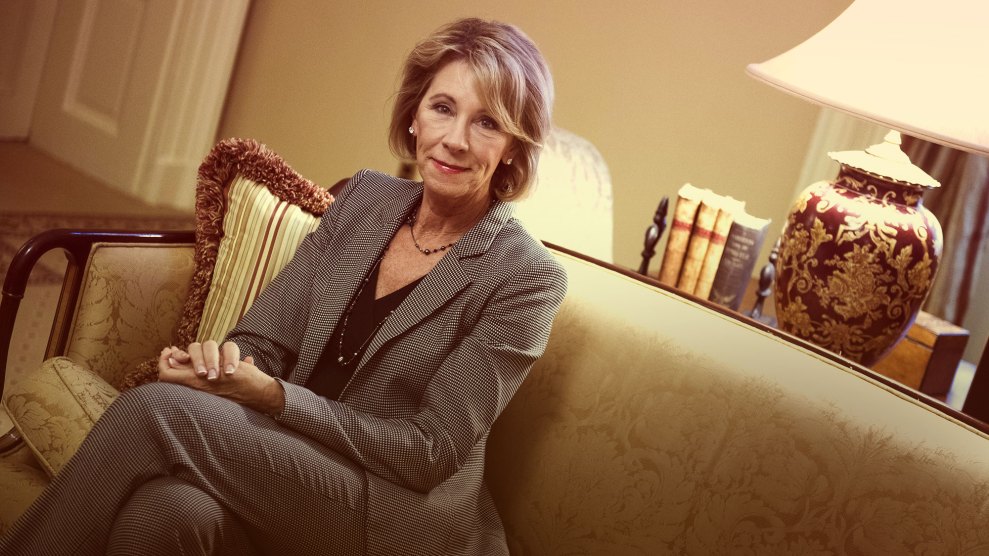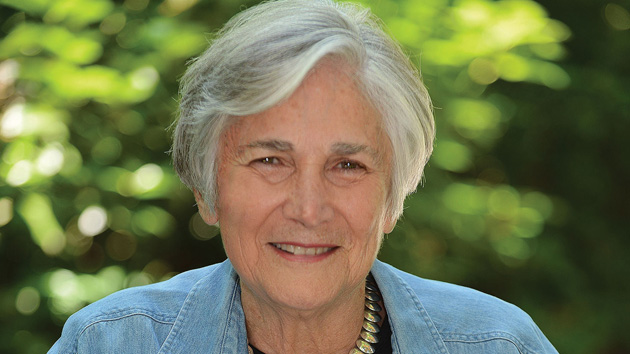The west side of Columbus, Ohio, is a flat expanse of one-story houses, grimy convenience stores, and dark barrooms, and William Lager, in his business wear, cut an unusual figure at the Waffle House on Wilson Road. Every day, almost without fail, he took a seat in a booth, ordered his bottomless coffee, and set to work. Some days he sat for hours, so long that he’d outlast waitress Chandra Filichia’s seven-hour shift and stay on late into the night, making plans and scribbling them down on napkins.
The dreams on the napkins seemed impossibly grandiose: He wanted to create a school unlike anything that existed, a K-12 charter school where the learning and teaching would be done online, and that would give tens of thousands of students an alternative to traditional public schools across the state. It would offer them unheard of flexibility—a teen mom could stay with her child and study, while a kid worried about being bullied could complete lessons at home. And it would be radically cheaper than a traditional classroom, since there would be no buildings to maintain, no teachers’ unions to bargain with. At the time—the late 1990s—it was a revolutionary idea. Lager called it, in the heady days when the internet seemed to promise a solution to every problem, the Electronic Classroom of Tomorrow.
But back then—before Lager had his mansion and lake house, before he rose to become a hero of the school choice movement, before Jeb Bush flew in to give ECOT’s commencement speech and Betsy DeVos helped Lager transform Ohio’s educational landscape—Filichia, the Waffle House waitress, could tell Lager seemed broke. Balding, round-faced, and concentrating intently as he scribbled, he even once tried to pass off photocopies of discount coffee coupons, she says. But he didn’t plan on using a Waffle House as his office forever. “One of these days I’m going to have a real big business,” she remembers him telling her, “and you can come work with me, and you won’t ever have to work anywhere else.”
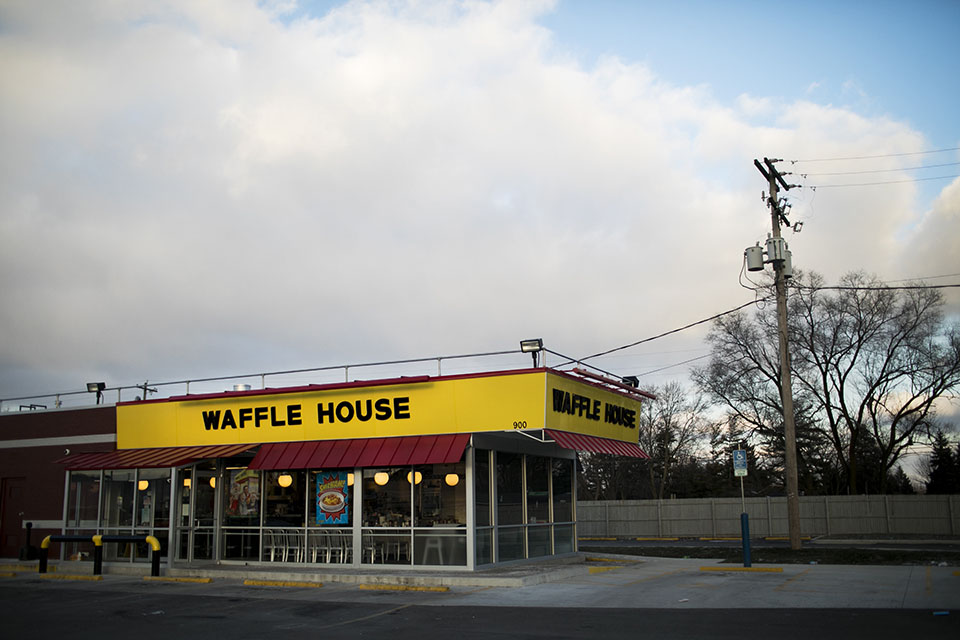
Bill Lager first began scribbling plans for his online-only public school on napkins while nursing a bottomless cup of coffee at this Waffle House.
Maddie McGarvey
Lager kept his promise, sort of. His back-of-the-napkin vision soon became an improbable reality, and though she’d never gone to college, in 2000 Lager hired Filichia, and eventually, she says, she became one of ECOT’s registrars. In that role, the 24-year-old had a front-row seat to the company’s growth. As it expanded from an upstart to a juggernaut—its student body was the largest in America in 2015—she began to turn on Lager, angered that the school seemed to provide some students with a sham education, functioned more like a profit center than a pedagogical institution, and ignored its own attendance policies, a fact later corroborated by court documents. “I am a single mom, so obviously I needed money and stayed there,” Filichia told me. “But after so long, when I saw how bad these poor kids were doing, I couldn’t do it anymore.”
In January, after 17 years of operation, the school came to a spectacular end. (Lager and ECOT officials did not reply to repeated requests for comment.) Despite years of critics raising concerns similar to Filichia’s, the school’s demise happened quickly, after two Ohio Department of Education reviews from 2016 and 2017 found that ECOT had overbilled taxpayers by $80 million for thousands of students it couldn’t show were meeting the department’s enrollment standards. As a result, the state ordered the school to begin paying back almost $4 million per month in school funds, which ECOT claimed it was unable to do.
Worried that ECOT wouldn’t have the funds to last out the year, the school’s charter sponsor, the Educational Service Center of Lake Erie West, suddenly announced plans to drop the school. Many of ECOT’s 12,000 students learned on the nightly news or read in newspapers that unless an emergency deal could be worked out, the institution was in imminent danger of folding, leaving many parents confused and panicking with only days to choose a new school and get their child enrolled.
The drama reached its climax on January 18. The board members of Lake Erie West held a public meeting in Toledo to vote. About 40 parents and teachers, some of them breaking down in tears, reportedly showed up. “If this is really about our children,” one parent, Lisa Burford, said, “I hope that you consider our children.” Burford explained that her daughter, who is deaf, had struggled with Toledo’s traditional schools and had been better off in ECOT’s online program, from which she was scheduled to graduate in May. ECOT had long been troubled—it had a graduation rate of just 40 percent and produced more dropouts than any other school in the nation, according to an investigation by the New York Times. But for some, it was a school of last resort, and now that last resort was about to vanish.
All three board members voted to withdraw their sponsorship of ECOT, effectively shuttering the school immediately. The decision cast doubt over whether Burford’s daughter and thousands like her would be able to graduate this year. But it also cast doubt over why Lager’s troubled school had been allowed to operate so long, and why it had been given almost $1 billion in taxpayer money that would otherwise have gone to local school districts.
In the wake of ECOT’s implosion, some state politicians have floated the idea that Lager, who has made millions of dollars off the school, should be held personally responsible for paying back some of the $80 million owed to the state. But it’s unclear how he might ever be held accountable—because the real scandal is that ECOT grew up legally, with the support of state politicians and national GOP power brokers, and that in many ways it has been held up as a model for schools like it across the country. Now, the same districts ECOT pulled its funds from are scrambling to find a way to take back its students, and Ohio is facing a reckoning after two decades as one of the country’s freest laboratories for pro-charter policies. “Why did it take a generation and a half of kids to go through this crappy system for us to do something about it?” Stephen Dyer, a former Ohio state representative, asked me in exasperation in December. “The reason is because a lot of money came in.”
Lager grew up poor, in an area of Columbus’ west side called the Bottoms—so-called “partially because it was in a flood plane (sic),” he would later write in a self-published book about the founding of ECOT, “and partially because the name fit.” His blue-collar parents had met in a factory when the state was still an industrial powerhouse and sent their kids to Catholic schools, where Lager excelled. He was elected class president all four years of high school before going on to Ohio State University.
He dropped out of college to join the Coast Guard Reserve during the Vietnam War and later returned to Ohio, hoping to run for office. But after family tragedy struck, he ditched politics and, in his early 20s, started an office-supply company that by his account had a few good years before eventually falling into debt. He filed for corporate bankruptcy and bounced around through a series of jobs as a lobbyist, an executive director of a nonprofit, and a salesman offering office supplies to state agencies. He went through a divorce and custody battle and eventually arrived at his lonely perch in the booth of the Waffle House on Wilson Road.
Lager, at this point about 50, may have been broke, but he had made a few good connections over the years. And he had a model: David Brennan, the first of Ohio’s charter school barons. Brennan, an Akron-based entrepreneur and a prominent GOP donor, earned millions of dollars “buying and selling manufacturing companies, slashing operating costs, and turning profits,” according to a 1999 article in the Akron Beacon Journal. He wore a white cowboy hat, a symbol of his noble intentions.
At the time, during the George H.W. Bush administration, the idea of a decentralized, privately run but publicly funded system of schools was just taking hold in national Republican circles. When Brennan threw a GOP fundraiser attended by Bush in 1990, it sparked an alliance with George Voinovich, a former Cleveland mayor and soon-to-be governor who bonded with Brennan over a shared vision of making Ohio a national experiment in privatizing education. In 1994, Brennan raised almost $1 million to help Republicans gain control of the state Legislature, and Voinovich won reelection.
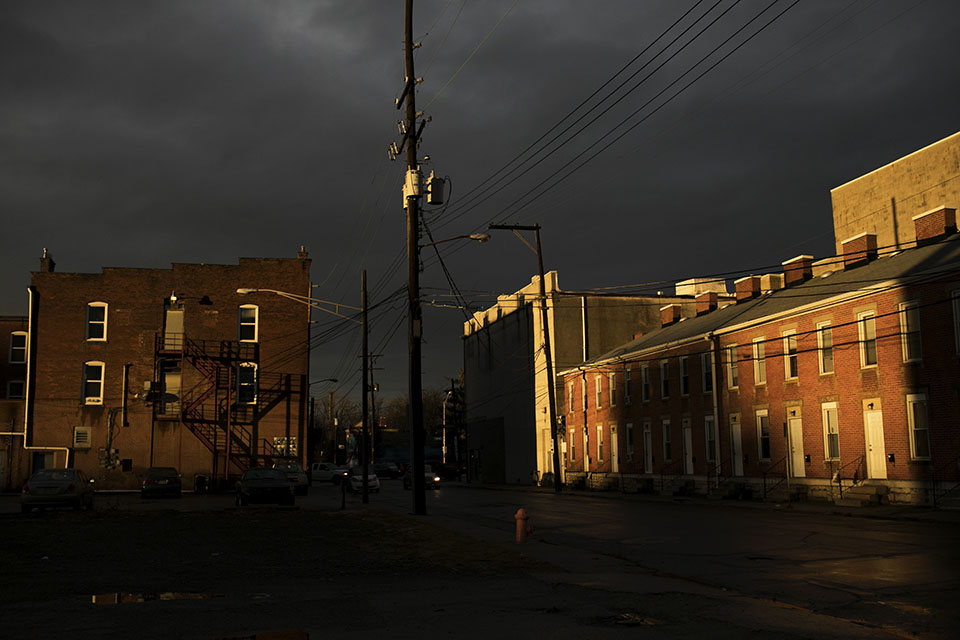
The Franklinton neighborhood of Columbus, also known as the Bottoms, where ECOT founder Bill Lager grew up
Maddie McGarvey
Three years later, the state passed a bill that created a pilot program allowing a school district to issue “charters”—legal authorizations that would allow private companies to manage public schools. The program spread quickly, and Brennan’s company, which he called White Hat Management, seized the moment. Operating with little state oversight, White Hat advertised for teachers without college degrees, drew thousands of dollars per student for its schools, and billed charters millions of dollars in “management fees.”
Brennan’s schools spread across the country, eventually totaling more than 50 facilities. But Ohio was especially open to innovation, and Brennan set the course for a massive expansion of the state’s charter system, leading some people to call it the “wild, wild West” of charters.

RELATED: Jeb Bush’s Cyber Attack on Public Schools
Lager decided to do Brennan one better—by getting rid of the need for brick-and-mortar facilities almost entirely. He began attending seminars offered by the Ohio Department of Education to help entrepreneurs through the process of applying for a charter. The department was initially skeptical of Lager’s idea, but he convinced the head of a Toledo-area agency that provided educational materials to public schools, the Lucas County Educational Service Center, to sponsor him. (In Ohio, charters need an agency sponsor, which can be a wide range of nonprofits, school districts, or universities, and which will take responsibility for monitoring the schools’ performance—while also sustaining itself at least in part on fees paid by the charters.) Lucas County ESC—since renamed Lake Erie West—would eventually receive $1.5 million a year in fees from ECOT, according to the Plain Dealer. “At that time,” Filichia remembers, Lager was “so broke” that he “borrowed my grandmother’s car to even go up to Toledo” to deliver the application.
Lager’s grand plan was to provide every student who enrolled at ECOT with a computer, and to do this—as well as design and deliver an online curriculum and provide internet service to the students who would use the computers—he needed money. He knew an executive at Xerox from a brief stint working there, and he pitched the company for $2 million in trade credit to get the business going. “They saw the power of the model immediately,” Lager wrote. He sold them on the idea that tech companies were in a position to lead a transformation in American education, and they knew “that if they didn’t come on board someone else would.” Lager called it “a paradigm shift no less extraordinary than the advent of the automobile or electricity,” a tech-fueled revolution in schooling that would push education even further into a “market-driven role.”
With backing from Xerox secured, Lager set up headquarters in a strip mall on a seedy stretch of South High Street in Columbus, located server space in Cincinnati, began to hire teachers, and designed a system the company used for the next decade and a half: ECOT would provide computers and internet service, and teachers would communicate with students via email and in chat rooms, augmented by periodic in-person field trips. ECOT itself was technically a public entity subject to state oversight, but Lager, inspired by a structure pioneered by Brennan and allowed by Ohio law, founded a for-profit management company called Altair that billed ECOT millions of dollars in fees for services like “strategic planning.”
To round out his administrative staff, Filichia says Lager tapped her and her family, most of whom hadn’t gone to college, and several of whom had also worked at the Waffle House—her mom, sister, two brothers, and former mother-in-law, along with four of her cousins and two of her aunts. “Pretty much just like our whole family,” she says.
Lager paid Filichia and her family $5 for every student they could sign up, she says. The school would come to draw many children whose families had been homeless, who had been in trouble with the law, or who had fallen hopelessly behind in their traditional schools. A teenage newlywed and dropout with a son at home called the school after her father learned about the launch on the radio. A boy named Richard, who had dropped out in 11th grade, had failed the GED exam, and was working as a groundskeeper, heard about the school on the news. “We just basically told them about the program, and they just enrolled,” Filichia remembers. “The districts here are bad anyway,” she says.
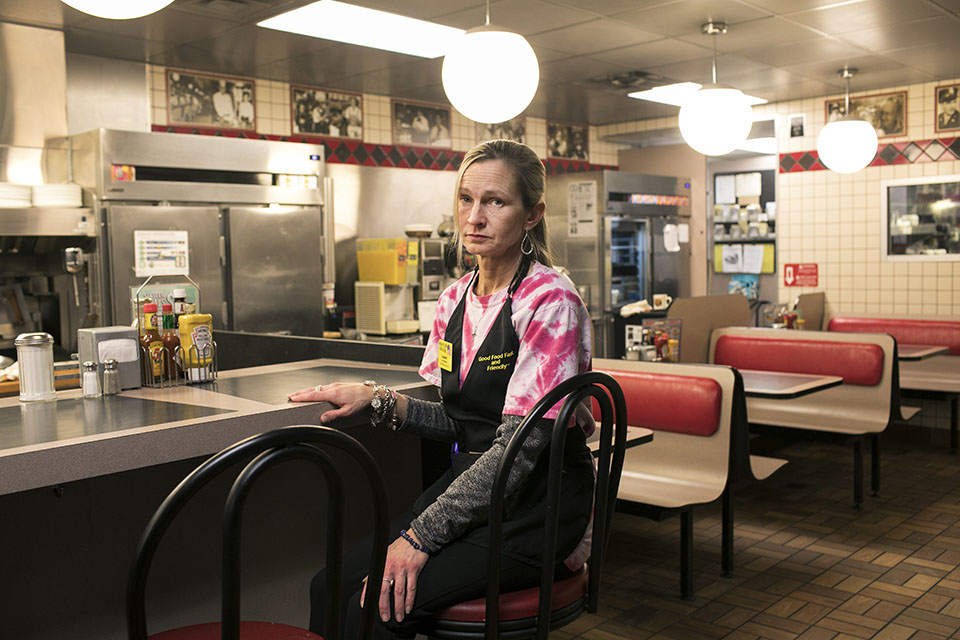
Chandra Filichia takes a break to sit in the Waffle House where she works in Columbus. Lager hired Filichia to work as an ECOT registrar.
Maddie McGarvey
ECOT was suddenly growing in a state where public school districts had been disastrously underfunded for decades. In many districts, the schools were literally falling apart. “I went to a school in Mount Gilead where classes were held in a basement converted coal bin,” one former Ohio education reporter remembered. “Frankly, if prisons had been in those conditions they’d be shut down.”
Free computers, which Lager sourced via Compaq, were a big selling point, especially for impoverished kids and their families. And Filichia believed in the school’s mission. Her younger half-brother, then a second-grader, Corey Messer, was one of the very first enrollees.
Classes began in September 2000, and by the end of the school year ECOT had 3,000 students and had become the state’s largest charter, bigger than many of Ohio’s public school districts, according to Lager. “We were given five months from the day that our charter was approved to the first day of school,” he wrote. “I’m pretty sure I couldn’t plan a wedding in that period of time (and given my track record with marriages, probably shouldn’t!).”
It soon became obvious there were problems. Jim Petro, then the state auditor, issued a brutal assessment of the school’s first year, finding that “ECOT did not have any written policies or procedures for enrolling students,” that it exhibited an “inability to provide computers to students at the beginning of the school year,” and that in two months there were “106 instances in which the reported student was either less than 5 years old or greater than 21 years old, contrary to legislated age requirements.” It also found that the school received almost $1 million in the month of September 2000 as payment for the students it claimed to be educating, although that month “only 7 students logged-in to one of the available computer-based instruction systems.” In other words, during the first month of operations, only about 1 of every 300 ECOT students managed to access Lager’s revolutionary new online education program.
Astonishingly, and despite the auditor’s conclusion that the school was paid an additional $1 million the following month for students it couldn’t account for, ECOT was allowed to carry on.
Twenty-one students managed to graduate that year—the first at an online-only K-12 charter anywhere in the country, according to Lager. “The graduates of the Electronic Classroom of Tomorrow Class of 2001 are pioneers of education,” he later wrote. “Their 21 diplomas will be collector’s items someday. As the kids might say, ‘This is tight!'”
By 2006, ECOT was growing into a behemoth, and Lager was growing rich. His private companies eventually billed ECOT for at least $153 million, most of it taxpayer dollars. These companies were largely insulated from state oversight. In 2002, a law put forth by Republican legislators had given oversight authority of certain charter schools to chartering agencies, like Lucas County ESC, which were left largely responsible for monitoring the schools that paid them. Charter management companies like Altair weren’t—and still aren’t—required to report what percentage of the state funds they received was paid out in individual salaries. But two early state audits show that at least in the first two years of ECOT’s operation, more than $1 million in fees paid to Altair went to Lager personally.
He began to pour that money into politics, donating $1.9 million over the course of 18 years, mostly to Republican candidates. Some high-level ECOT or Altair employees also frequently donated to pro-charter candidates, according to one former ECOT administrator and state records. “I was bothered by it, to a degree, but I stayed out of the politics and just did my job,” he said. “That was what I was getting paid for, and I didn’t care about getting involved with Mr. Lager or any of that other stuff.”
In one instance reported by the Akron Beacon Journal in 2006, Lager gave $10,000 over a four-day period to the gubernatorial campaign of the former auditor, Jim Petro, who had since been elected as the state’s attorney general. Four ECOT or Altair employees, along with their spouses, each donated $5,000 to Petro during the same four-day span—totaling at least $50,000 from ECOT and Altair staff during a primary campaign. One couple that contributed $24,500 had never donated to a state or federal campaign until that year. Petro lost but remained the attorney general. And soon, despite his lacerating assessment of ECOT’s first year, he gave the commencement address at the school’s 2006 graduation ceremony.
Some critics suspect Lager was trying to buy favorable policies for ECOT. Whether or not that was the case, the state certainly took an incredibly hands-off approach toward its oversight of the school. According to Ohio law, charter schools are required to provide students with at least 920 hours of “learning opportunities” per year—about 25 hours a week—and those who miss 105 consecutive hours have to be kicked off a school’s rolls and potentially face truancy proceedings. But under an agreement negotiated with the Department of Education in 2003, ECOT wasn’t required to track hourly coursework—it simply counted students as properly enrolled as long as they logged into a computer at least once every 30 days.
Statements from current and former school administrators—which I found buried in depositions made as part of ECOT’s recent legal fight—show that as recently as the 2015-16 school year, students could be legally counted as enrolled even if they only logged into the ECOT systems but never accessed learning material. And in order to keep a student enrolled, and for ECOT to receive state funding, a teacher simply had to note that a student had engaged in some kind of learning or a field trip. A document from one ECOT class leaked to ProgressOhio, a watchdog group, suggested that activities like watching “television documentaries” and “working on cars” were kinds of learning that students “could/should self-report.”
ECOT administrators, in other words, interpreted the law to mean that they only had to show a student could potentially have completed 920 hours of learning time, without the school being required to track it. ECOT’s deputy superintendent argued in a deposition that the school ought to receive full funding for a student if the student logged on for only a single minute every month—just frequently enough to avoid truancy proceedings. “I believe that if ECOT has made the educational opportunity available,” he said, “that we should be fully funded.” Until 2016, the Ohio Department of Education didn’t push back.
Across the country, many state legislatures were increasingly permissive of charter schools, and their enrollments were skyrocketing. From 2006 to 2016, they would nearly triple their enrollments nationwide, from 1.2 million students to 3.1 million. In Ohio, the system had grown from almost nothing to 70,000 students in just 10 years, and the charter lobby was becoming one of the most influential in the state. “There were a lot of powerful lobbies in Columbus,” Stephen Dyer, who was elected to the Ohio House in 2006, told me. “You had coal, you had general energy companies, you had nursing homes. I never saw any sector get everything they wanted except charters.”
Amid the national wave that overturned the GOP majority in 2006, Ted Strickland, a Democrat who wanted to get a handle on charters, was elected as Ohio’s first Democratic governor in 25 years. But a sudden flood of almost $900,000 in campaign cash from a group headed by Betsy DeVos, who long before becoming Trump’s education secretary was active in pushing the most radical approaches to school deregulation, helped to keep Ohio’s House of Representatives in Republican hands. Over the four years of Strickland’s tenure, charter industry allies in the Legislature blocked many of the governor’s attempts. “I don’t think all political contributions are efforts to do something nefarious,” Strickland told me. “But in this case, I think it was so obvious that these schools were so bad and were failing and had such lax oversight. I cannot give the Republican Legislature the benefit of the doubt and say that they did not know.”
“When you have a situation where public moneys are used to enrich individuals,” he added, “who then in turn support the politicians that support the policies that enrich them—it may not be illegal, but I think that fits the definition of corruption.”
Even if the GOP-controlled Legislature didn’t see anything troubling about ECOT, officials on the ground did. On March 20, 2006, Keith Richards, the superintendent of public schools in Newark, Ohio, wrote a letter to Lucas County ESC, the sponsor of ECOT’s charter. He sent a copy to Petro, who had published the audit of ECOT’s chaotic first year and was now Ohio’s attorney general. Richards, a tall, white-haired veteran of several districts around the state, described himself as a “wholehearted” supporter of the idea of charter schools; he’d even helped set up one in his district. But as Newark students began to drift into ECOT, he became concerned. “Of the 132 former Newark students who have attended ECOT this year,” he wrote, “we have found many violations…with regard to enrollment, attendance, instruction time and activity, and withdrawal procedures.”
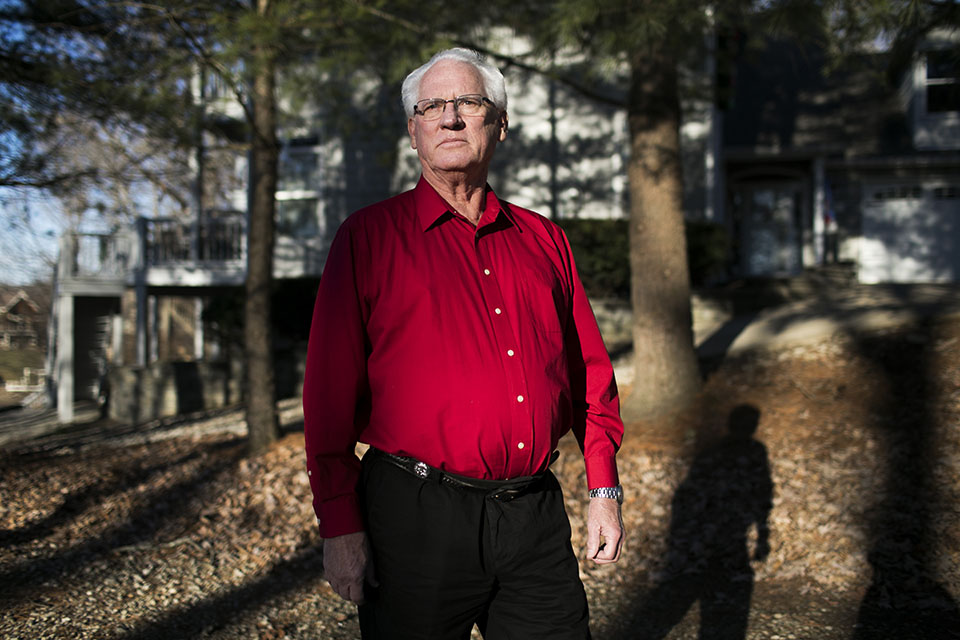
Keith Richards, a former superintendent of public schools in Newark, Ohio, outside his home
Maddie McGarvey
He went on to describe problems noticed by local truancy officers, who had attempted to establish that the students who withdrew from the district were actually attending school. “We have documentation that shows that four ECOT students…do not have [a] computer or even, in some cases, internet access in their homes,” he wrote. “We know of one student who was enrolled in ECOT for two years…and who was never given a computer or ECOT coursework.”
The Newark attendance officer filed truancy charges in that case, according to the letter, and truancy charges would eventually be brought to bear on as many as 1,200 ECOT families every year.
“We are aware of more than a dozen former Newark students currently ‘enrolled’ in ECOT who have not met the mandatory requirement of logging in,” Richards’ letter continued. “We are not lawyers, but we wonder if ECOT is fraudulently collecting state dollars for students it is not educating.”
That year, ECOT received $366,149 from Newark City Schools and nearly $40 million from the Ohio Department of Education overall. ECOT had reported a 100 percent attendance rate for its roughly 6,700 students on state documents. “That obviously doesn’t sound right,” admitted a spokesman to Education Week.
I met Richards, now retired, at a Cracker Barrel north of Columbus. He handed me a copy of the letter and a year-by-year accounting of all the money the district had sent to ECOT, an average of about $350,000 annually from 2002 to 2016, in a district of only about 7,000 students. I asked what it was like as an administrator to lose that much money. “We actually broke that down,” he said. “And we’re talking about four teachers [for each of those years]. We’re talking about whether we have aides for special-needs kids.
“We ended up having to cancel high school busing. We went to pay-to-participate extracurricular activities,” Richards continued. Combined with budget shortfalls, these changes affected thousands of students and parents in a small, poor city devastated by deindustrialization and soon to be hit again by the financial crisis. They tried to pass a levy—a voter-approved attempt to raise money locally—to help recoup funds. “We finally, after four attempts,” he said, “got a levy passed. But they never brought back high school busing.”
In June 2010, Jeb Bush flew to Columbus to give the commencement speech at ECOT’s graduation. It was just one among several efforts to boost Lager’s business. The next year, Bush would push for increased funds for e-schooling in Ohio—never mind that ECOT’s test scores were some of the worst in the state, worse than those in all but 14 of 609 Ohio school districts. And in the months following his commencement address, Bush would convene a Digital Learning Council with support from major tech companies including Apple, Google, and Microsoft. The council—which Lager sat on—contributed to laws in Florida, Utah, and Wisconsin that helped steer public money to online education companies. Nationwide, online charters would soon educate an estimated 200,000 students a year, even as one study of their performance compared the educational shortfalls they produced to a student losing “72 days of learning in reading and 180 days of learning in math” out of a normal school year. “The US education system currently operates as an eight-track tape in an iPod world,” Bush said, after Gov. John Kasich signed a 2011 bill encouraging e-learning in the state. “Ohio is on a path to transform education for the 21st century.”
If the results of e-learning were mixed, ECOT’s business model was an unmitigated financial success for Lager and the company. A year after Bush’s visit, ECOT had expanded its little strip mall office into a massive, gleaming headquarters. The school now employed more than 500 teachers and had grown by 1,800 students from the previous academic year. Filichia—divorced and raising two kids—had signed on dreaming of a six-figure salary and a professional career of a kind she’d never considered possible before she met Lager. But she found herself still working on and off at the Waffle House to make ends meet, even as she registered thousands of new students and watched Lager, whom she once pitied, host figures like Bush at the school’s commencement events.
As a registrar, she described herself as being in a position to see the school’s attendance problems. She said kids who hadn’t logged on in weeks would call after being threatened with truancy proceedings, begging her for help. (Children who’d experienced the death of a parent or who had one who was receiving disability payments could qualify for Social Security assistance as long as they remained in school.) “‘I need my money so that I can pay my car insurance,'” Filichia recalled them telling her. “Or, ‘I don’t have enough money to get my baby milk this week. Can you please make sure Social Security gets my check for me?'”
She says she took dozens of calls a day from anxious students.
“I would see the kids that weren’t logging in,” she continued, “and would have to…send a letter to Social Security, and I would hate doing it, but I had to. I wasn’t breaking the law—that’s what I told [them]. I would even call and tell them, ‘You need to log in and do a couple assignments or else I’m not sending nothing but a letter to terminate your case,’ at which point they would start working. But it was horrible. It was pitiful.”
The difficulties ECOT families faced weren’t confined to children whose parents, for whatever reason, didn’t monitor their schooling. “Once enrolled in ECOT, I had trouble from the start,” one mother told a state Senate committee hearing on a bill—derailed by the GOP state Senate president, who had received donations from Lager—to address e-school attendance problems in 2016. “There were always technical issues, as far as logging in and uploading their homework into the electronic drop box. I was constantly on the phone with technical support,” she said. “I would never be able to speak to an actual teacher. I would leave voicemails, but most of my calls were never returned. Needless to say, my children failed seventh and fifth grade. I was devastated.”
I spoke with another parent, a divorced mother of two in an upper-middle-class suburb of Cleveland, who chose ECOT for her kids after she lost her job and moved out of her district and her plan to enroll her children in their old high school fell through. She described the lessons her kids completed as comically simple and said that even though she made sure they logged in and did their work regularly, the quality of the instruction was so poor they lost a semester. The school was still subject to state requirements and testing, but it reported, like all charters in Ohio, to its charter sponsor, which monitored its performance. She eventually rented a second home in their former school district, in large part to get her kids out of ECOT.
A recent deposition sheds some light on the loosely defined expectations placed on ECOT students. Jeffrey Forster, a former ECOT superintendent, was asked by a lawyer for Ohio’s Department of Education how administrators verified that students had attended a full year of school. Forster recalled, as an example, how one day in 2009, ECOT gathered its teachers in a Columbus-area DoubleTree hotel and over the course of 10 hours had them verify attendance for as many as 14,000 students. They passed the forms around a string of lined-up tables and worked from memory as much as from login or attendance records. “And they look it over and they say, ‘Okay, John Jones. Yeah, I know John Jones,’ and sign it and put it in the outbox,” he said. If no one recalled a student, the teachers—each of whom could have had dozens of pupils, sometimes many more—would look on their rosters to see if they could find the name. Many of the students presumably had done their schoolwork in good faith, and if a student had definitively dropped out the teachers would decline to sign. But the verifications seemed to have nothing to do with how much time the student actually spent doing classwork. “It wouldn’t matter how often Sally Sue logged on to any online learning for ECOT,” a lawyer for the state asked Forster, “whether that teacher would sign that document?”
“It would not matter,” Forster answered.
Students, in fact, weren’t required to participate in online classroom learning at all, according to another ECOT official’s testimony regarding the 2015-16 school year. (Educational requirements could be satisfied through field trips or homework.) Filichia’s half-brother, Corey Messer, one of the school’s early enrollees, recalls school officials logging learning time for him when he hadn’t done classwork, a practice Filichia also remembers. Messer, who suffered a stroke at birth and still struggles with the aftereffects, says he seldom did schoolwork.
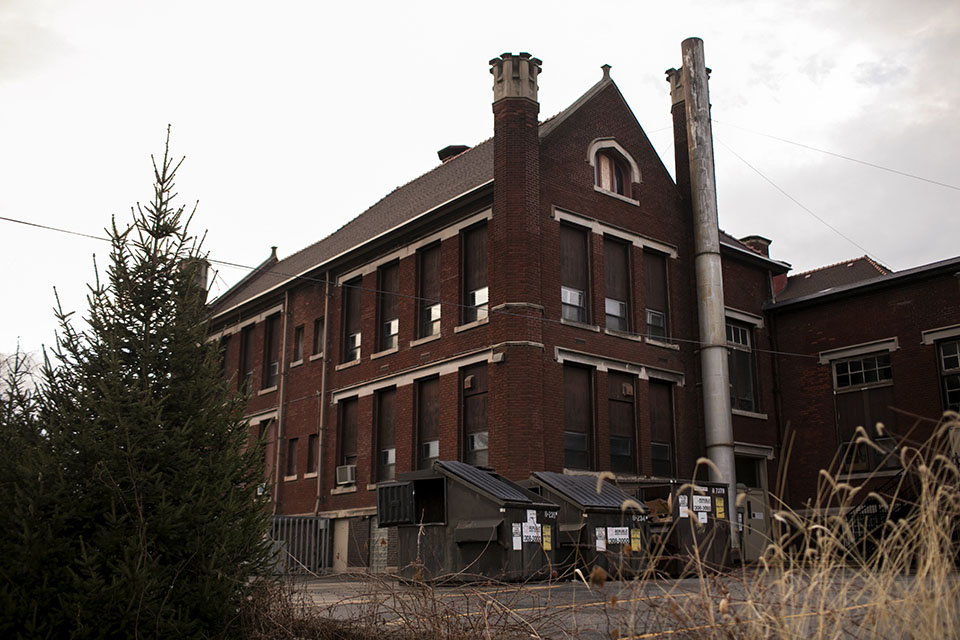
A closed school in the Franklinton neighborhood
Maddie McGarvey
“My parents worked all the time so they couldn’t stay on me about my work,” he said. “When you see that there’s not consequences for [not] doing it—I don’t see very many people acting different.”
“Nobody there would listen when I would say, ‘These kids aren’t learning,'” Filichia told me. She finally quit in 2016 and went back to waitressing full time at the Waffle House. “We’re not teaching them nothing. We’re hurting them.”
Messer, for his part, was given an ECOT diploma even though he hardly ever did classwork. He’s now 26 and works as a pizza delivery driver. “Everything that I’ve learned I’ve picked up on my own,” he said, “and I think with that being said, I don’t do as bad as I could be doing. But I definitely don’t feel like someone that graduated high school.”
Despite all the glaring failures, until very recently ECOT seemed untouchable. Gov. George Voinovich, David Brennan’s early ally, whom he hosted at the GOP fundraiser in 1990, was followed by numerous state politicians who seemed just as enamored of the idea of privatizing the state’s education system, and who grew close to ECOT, accepting Lager’s lavish contributions and frequently appearing at school events. Dave Yost, the Republican state auditor, spoke at an ECOT commencement, accepted at least $29,000 in campaign donations from companies and people affiliated with ECOT, according to Cleveland.com, and on one occasion personally presented the school with an award for quality in financial audits. Officials in the administration of Gov. John Kasich also helped to direct millions of dollars in government contracts to another Lager company, which had donated $153,649 to the Republican Governors Association to help Kasich get elected, according to ProgressOhio, the watchdog group. That company, IQ Innovations, was tapped to build an e-learning platform, accessible to K-12 schools across the state, but ultimately was unable to deliver. Kasich gave ECOT’s 2011 commencement address. “You will have had no other speaker more committed to the ECOT idea than Governor Kasich,” Lager told the crowd that day. “With his help, we see nothing but clear sailing.”
Only in recent months have Ohio politicians begun to distance themselves from the school. Last August, the state Republican Party returned $38,000 in donations from Lager and another $38,000 from his lieutenant at Altair, Melissa Vasil. Yost put Lager on warning in January by publicly suggesting that the ECOT founder, who over the years has purchased a $3.7 million home in Key West, Florida, along with a lakeside retreat and properties around Columbus, could be expected to personally repay some of the tens of millions of dollars ECOT owes the state. A few days later, a framed photo of Yost was reportedly removed without explanation from the lobby at ECOT’s headquarters.
“I don’t think there’s any conscionable reason why Lager should make the profits that he makes off of educating kids in public schools,” a former ECOT administrator told me. He defended his accomplishments at ECOT and said that for many children he worked with, online schooling really was the best option—safer for kids who had been bullied or threatened by gangs, and more flexible for students whose families might be transient.
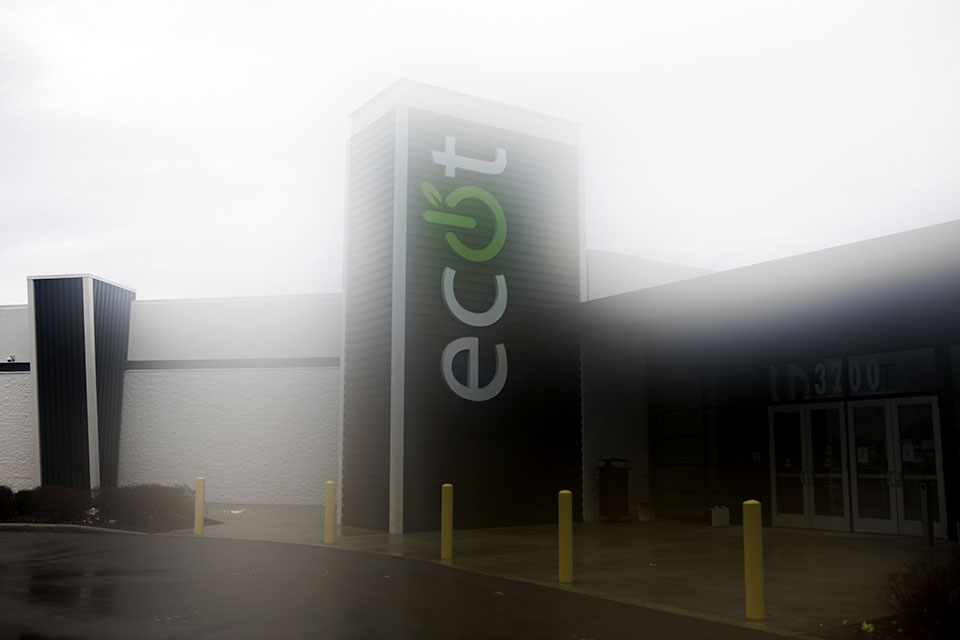
The ECOT headquarters used to be a strip mall in Columbus, OH.
Maddie McGarvey
But those successes came at the cost of more than $1 billion in public funding, much of it diverted from better performing Ohio schools, and at least 15 percent of that money—about $150 million—was paid to Lager’s private companies, subject to almost zero oversight or transparency. In 2017, Columbus’ public schools posted a four-year graduation rate of 74 percent. ECOT’s was 40 percent. Nevertheless, that year Columbus schools sacrificed $11 million in funding—about 3 percent of their total state allocation—to ECOT.
“If a lot of that money would have been for the school, instead of for the company that runs the school,” the former administrator told me, ECOT “could have done a much better job of educating kids.”
And while ECOT’s closure might seem like a long-overdue comeuppance for Lager and his supporters, charters like it still proliferate around the country and may soon become even more common: Trump’s 2018 education budget proposed $1.4 billion in additional federal funding for school choice programs like charters, even while cutting $9 billion from the Department of Education overall. Last November, Betsy DeVos gave a speech to yet another pro-charter group founded by Jeb Bush, specifically trumpeting the potential of new e-learning schools, and warning teachers’ unions and Democrats in Congress who might oppose such new proposals that “I’m not going anywhere. In fact, I’m just getting started!”
In Ohio, taxpayers and former students will be living with the impact of the ECOT experiment for decades. Many students and parents, in fact, feel like they’ve been living with the consequences for years. “It’s too late now,” Tabatha Cruikshanks, a waitress, told me in December, referring to her daughter, Cortnee. Cruikshanks served Lager at the Waffle House way back when ECOT was still just a dream on a napkin, and when Cortnee became pregnant at 15 she enrolled at ECOT, quickly slipped through the cracks, and dropped out. Now she works with her mother as a waitress. “I know she could’ve went and did more things,” Cruikshanks told me.
Lager, for his part, seldom emerges in public and has mostly stayed out of the spotlight during the current crisis. But last May, after the state first told the school it owed tens of millions of dollars, he made an appearance to speak at a rally in support of ECOT in Columbus. ECOT attempted to require all employees to attend the rally, held on a school day, but the order was leaked and the company was forced to backtrack. Lager presented a very different face from the one he’d shown back when he made his way into the Waffle House on Wilson Road. He wore a brown sports coat and a trim silver beard, and the crowd, some of whom had been bused in from the headquarters on South High Street, cheered him wildly. “I traveled about Ohio in those early days,” he told them. “And I met over 10,000 families that all told me the same thing: ‘Help me help my child.'”
This text has been updated and revised.
Top image credit: Chris Kleponis/picture-alliance/dpa/AP Images; MediaPunch/REX/AP

